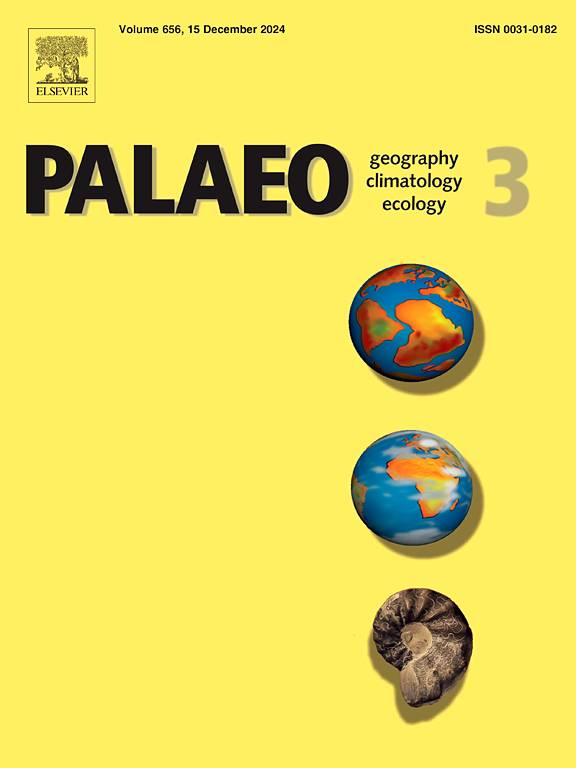华北不同草原类型花粉-植被-气候关系:第四纪植被和气候重建的意义
IF 2.7
2区 地球科学
Q2 GEOGRAPHY, PHYSICAL
Palaeogeography, Palaeoclimatology, Palaeoecology
Pub Date : 2025-06-18
DOI:10.1016/j.palaeo.2025.113102
引用次数: 0
摘要
温带草原在不同的气候梯度下表现出复杂的植被类型和多样的特征。然而,为了利用花粉数据重建温带草原植被和气候的过去变化,建立更精确的花粉、植被和气候之间的现代关系至关重要。本文报告了锡林郭勒草原149个样点的植被调查和孢粉学分析结果,并应用Kriging插值和排序分析等统计分析方法,对现代花粉组合对植被和气候梯度的反映进行了评价。结果表明,紫花科和蒿属植物在草原地表花粉组合中占主导地位。花粉组合的空间异质性非常显著,可以区分草甸草原、典型草原和荒漠草原。禾科植物花粉的比例是区分草原类型的关键指标,从草甸草原到典型草原,再到荒漠草原,逐渐减少约75%。苏科花粉是草甸草原景观的典型代表,而葱属和蒺藜属花粉是荒漠草原景观的标志。树木花粉,主要是外源输入,如来自大兴安岭的松树,反映了外部影响。区域降水是影响地表花粉组合空间变化的最关键气候因子。苋菜科和蒺藜科花粉的高百分比表明干旱气候,而苏柏科花粉的高百分比是湿润气候的重要指标。本研究为探索东亚草原花粉的现代过程提供了详细可靠的证据,提高了重建过去环境变化的准确性。本文章由计算机程序翻译,如有差异,请以英文原文为准。
Pollen-vegetation-climate relationships in different steppe types of North China: implications for Quaternary reconstructions of vegetation and climate
Temperate steppes exhibit complex vegetation types and diverse characteristics across varied climate gradients. However, to reconstruct past changes in temperate steppe vegetation and climate using pollen data, it is essential to establish more precise modern relationships between pollen, vegetation and climate. In this paper, we report the results of detailed vegetation surveys and palynological analyses for 149 sampling sites in the Xilingol Steppe, and apply a series of statistical analysis methods, including Kriging interpolation and ordination analysis, to evaluate how modern pollen assemblages reflect vegetation and climatic gradients. Our results show that Amaranthaceae and Artemisia dominate the surface pollen assemblages of the steppe. The spatial heterogeneity of pollen assemblages is highly significant and allows us to distinguish meadow steppes, typical steppes, and desert steppes. Specifically, the percentage of Poaceae pollen serves as a key indicator for differentiating steppe types, decreasing progressively by approximately 75 % from meadow steppes to typical steppes and then to desert steppes. Cyperaceae pollen typically represents meadow steppe landscapes, whereas Allium and Tribulus pollen are indicators of desert steppes. Arboreal pollen, primarily exogenous inputs such as Pinus originating from the Greater Khingan Mountains, reflects external influences. Regional precipitation emerges as the most critical climatic factor influencing the spatial variation of surface pollen assemblages. High percentages of Amaranthaceae and Tribulus pollen indicate arid conditions, and the percentage of Cyperaceae pollen serves as an important indicator of humid climates. In summary, this study provides detailed and reliable evidence for exploring the modern processes of pollen in East Asian steppe regions and enhances the accuracy of reconstructing past environmental changes.
求助全文
通过发布文献求助,成功后即可免费获取论文全文。
去求助
来源期刊
CiteScore
5.90
自引率
10.00%
发文量
398
审稿时长
3.8 months
期刊介绍:
Palaeogeography, Palaeoclimatology, Palaeoecology is an international medium for the publication of high quality and multidisciplinary, original studies and comprehensive reviews in the field of palaeo-environmental geology. The journal aims at bringing together data with global implications from research in the many different disciplines involved in palaeo-environmental investigations.
By cutting across the boundaries of established sciences, it provides an interdisciplinary forum where issues of general interest can be discussed.

 求助内容:
求助内容: 应助结果提醒方式:
应助结果提醒方式:


